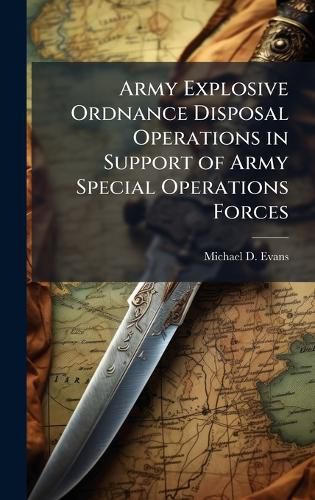Readings Newsletter
Become a Readings Member to make your shopping experience even easier.
Sign in or sign up for free!
You’re not far away from qualifying for FREE standard shipping within Australia
You’ve qualified for FREE standard shipping within Australia
The cart is loading…






This title is printed to order. This book may have been self-published. If so, we cannot guarantee the quality of the content. In the main most books will have gone through the editing process however some may not. We therefore suggest that you be aware of this before ordering this book. If in doubt check either the author or publisher’s details as we are unable to accept any returns unless they are faulty. Please contact us if you have any questions.
Army Special Operations (ARSOF) are a significant contributing force in the Global War on Terrorism and have no explosive ordnance disposal (EOD) support other than on an ad hoc basis. The EOD support provided ARSOF, while competent and trained for conventional operations have not undergone any unique preparation for operations in support of ARSOF. There has been no formal effort to engage both ARSOF and EOD in order to optimize integration. This study assesses what can be done to insure that ARSOF is provided focused and trained EOD in support of missions in a unique operational environment. Conventional forces have ready access to EOD support though relationships established in the continental United States, the Combat Training Centers and past contingency operations. The Army's Cold War focus, resulted in EOD being organized and equipped primarily to support conventional forces. The operational environment has changed. The US can no longer expect to fight predominately high intensity mechanized battles on linear, contiguous battlefields. Future opponents will employ asymmetric methods in order to avoid our strengths. ARSOF is central to combating these threats. Proliferation of CBRN technology and the continued use of improvised explosive devices in attacks globally demands a rigorous research effort.
This work has been selected by scholars as being culturally important, and is part of the knowledge base of civilization as we know it. This work was reproduced from the original artifact, and remains as true to the original work as possible. Therefore, you will see the original copyright references, library stamps (as most of these works have been housed in our most important libraries around the world), and other notations in the work.
This work is in the public domain in the United States of America, and possibly other nations. Within the United States, you may freely copy and distribute this work, as no entity (individual or corporate) has a copyright on the body of the work.
As a reproduction of a historical artifact, this work may contain missing or blurred pages, poor pictures, errant marks, etc. Scholars believe, and we concur, that this work is important enough to be preserved, reproduced, and made generally available to the public. We appreciate your support of the preservation process, and thank you for being an important part of keeping this knowledge alive and relevant.
$9.00 standard shipping within Australia
FREE standard shipping within Australia for orders over $100.00
Express & International shipping calculated at checkout
This title is printed to order. This book may have been self-published. If so, we cannot guarantee the quality of the content. In the main most books will have gone through the editing process however some may not. We therefore suggest that you be aware of this before ordering this book. If in doubt check either the author or publisher’s details as we are unable to accept any returns unless they are faulty. Please contact us if you have any questions.
Army Special Operations (ARSOF) are a significant contributing force in the Global War on Terrorism and have no explosive ordnance disposal (EOD) support other than on an ad hoc basis. The EOD support provided ARSOF, while competent and trained for conventional operations have not undergone any unique preparation for operations in support of ARSOF. There has been no formal effort to engage both ARSOF and EOD in order to optimize integration. This study assesses what can be done to insure that ARSOF is provided focused and trained EOD in support of missions in a unique operational environment. Conventional forces have ready access to EOD support though relationships established in the continental United States, the Combat Training Centers and past contingency operations. The Army's Cold War focus, resulted in EOD being organized and equipped primarily to support conventional forces. The operational environment has changed. The US can no longer expect to fight predominately high intensity mechanized battles on linear, contiguous battlefields. Future opponents will employ asymmetric methods in order to avoid our strengths. ARSOF is central to combating these threats. Proliferation of CBRN technology and the continued use of improvised explosive devices in attacks globally demands a rigorous research effort.
This work has been selected by scholars as being culturally important, and is part of the knowledge base of civilization as we know it. This work was reproduced from the original artifact, and remains as true to the original work as possible. Therefore, you will see the original copyright references, library stamps (as most of these works have been housed in our most important libraries around the world), and other notations in the work.
This work is in the public domain in the United States of America, and possibly other nations. Within the United States, you may freely copy and distribute this work, as no entity (individual or corporate) has a copyright on the body of the work.
As a reproduction of a historical artifact, this work may contain missing or blurred pages, poor pictures, errant marks, etc. Scholars believe, and we concur, that this work is important enough to be preserved, reproduced, and made generally available to the public. We appreciate your support of the preservation process, and thank you for being an important part of keeping this knowledge alive and relevant.